With opposition only weeks away, will the current global dust storm finally break? We look at the prospects.
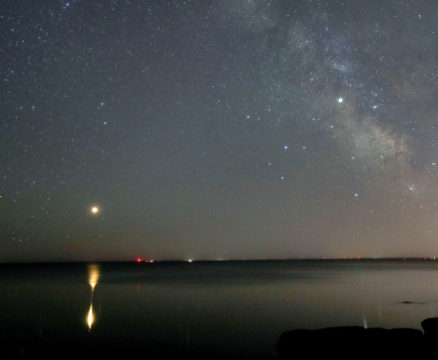
Bob King
Mars rises brilliant and inviting these July nights, but the view through a telescope reveals little more than a blurry, orange ball devoid of surface features. Many of us knew in advance we'd have to put up with poor seeing because of the planet's southerly declination. We also knew of the possibility of dust storms. But few expected such a massive, planet-girdling storm to occur this early in the most favorable apparition of the Red Planet since 2003.
Roger Venable, coordinator of the Association of Lunar and Planetary Observers (ALPO) Mars Section, describes the current storm as "unique in the history of observed Martian dust storms."
Though sometimes compared to the 2001 global storm, that event occurred closer to the start of Martian summer and in a more traditional location, the familiar tempest-breeding grounds of Hellas Basin in Mars's southern hemisphere. The current global storm took shape in the northern hemisphere and much earlier than usual, only nine days into southern hemisphere spring.

ESA / DLR / FU Berlin (G. Neukum) / Justin Cowart
"All of the historical dust storms of this size began in the southern hemisphere, in the areas of Hellas, Noachis, or Argyre," said Venable in an e-mail. "The present global dust storm began in Mare Acidalium. There has been considerable dust activity in Mare Acidalium in the last several apparitions, but nothing on this scale was expected."
Instead of settling down, the storm metastasized and struck south and west for Chryse, Sinus Meridiani, and kept going. One feature after another succumbed to billows of rusty dust until, by June 19, the storm achieved global domination. Amateurs gritted their teeth.
We're now fewer than three weeks away from opposition, and so much airborne grit still chokes the Martian atmosphere that once-prominent dark albedo features such as Sinus Meridiani, Syrtis Major, and Mare Cimmerium are practically unrecognizable. Even the south polar cap hasn't escaped the squall. It looks like a dollop of peach ice cream!

NASA / Damian Peach
Dust also continues to keep NASA's Opportunity Rover hunkered down, sucking away the sunlight the rover's solar panels need to recharge its batteries. Mission control checks the rover every day but has received no response since Opportunity put itself into sleep mode after last contact on June 10.
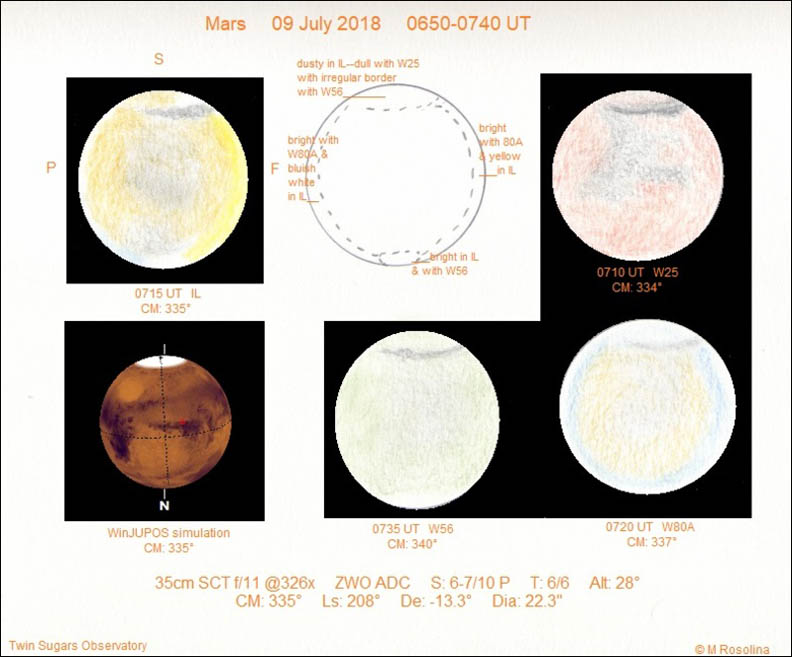
Michael Rosolina
Like you, I've attempted visual observations in 10-inch and 15-inch telescopes but have been stymied to identify much of anything. At best I've seen a few ambiguous gray markings, a vague, low-contrast south polar cap, and the white northern rim of the planet betraying the presence of the north polar hood. Otherwise, Mars is mostly a tease right now: brilliant and big in the telescope but cloaked in a gritty fog.
Have you noticed the change in the planet's color? Normally reddish-orange or even pink, Mars now glows pumpkin-orange. Even my eyes can see the difference. ALPO assistant coordinator Richard Schmude has also noted an increase in brightness of ~0.2 magnitude concurrent with the color change.
Naked-eye skywatchers can use the boost to their advantage by attempting to see Mars in daylight shortly after sunrise. Italian amateur Giorgio Rizzarelli has spotted it on five different mornings from the balcony of his home several minutes after sunrise. Locate the planet low in the southwestern sky in twilight and line it up with a building or tree. Keep an eye on it as sunrise approaches. Mars is currently magnitude —2.5 and about 10° high (from mid-30° to mid-40° latitudes) minutes after sunrise. Because it's sinking lower each morning, now is the time to make this rare sighting.
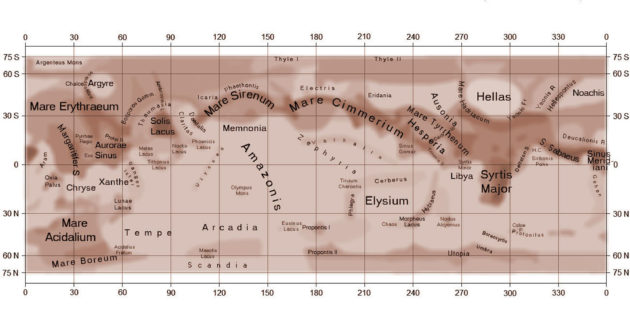
A.L.P.O.
The 2001 storm blew up in July and finally dissipated about three months later in October, some four months after opposition. The current storm, which has evolved in a similar manner, may follow the same trajectory and linger for another couple months, putting a serious crimp in amateurs' observing goals. One thing is certain. While Martian dust, heated by the Sun, has warmed the atmosphere, the same dust has reduced the amount of solar radiation reaching the ground, gradually cutting off the storm's energy supply. As the surface cools, the gale will lose its power, dust will settle, and skies will clear eventually.
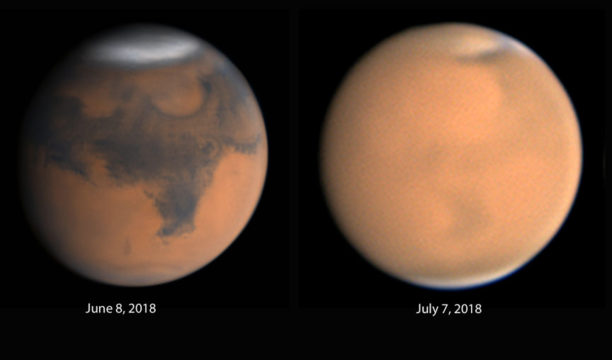
Damian Peach / Chilescope team (left), Christophe Pellier
Venable notes that the number of denser "dust cores" has declined since the start of July, a sign that the storm may be losing strength.
"Generally, once the dense dust cores cease to occur, a relatively uniform haze of dust continues over the entire planet for a couple of months, gradually settling," said Venable. "The normal albedo features of the planet gradually reappear, regaining their normal contrast."
Scott Guzewich, atmospheric scientist at NASA’s Goddard Space Flight Center, struck a note of optimism, writing in a July 5th blog that "the amount of dust over Gale Crater has been slowly declining over the last two weeks, and it’s possible the dust storm has reached its ‘peak"'.
When a broader clearing will happen remains unknown. And while I've heard of other minor clearings at this and that Martian longitude, the whole planet remains under a pall of dust, thicker here, thinner there. Meanwhile, opposition looms. If we have to wait several months for the storm to clear as in 2001, good views of surface features will elude observers until the start of September, when Mars will have faded to magnitude –2 but still sport a respectable 20″ disk.
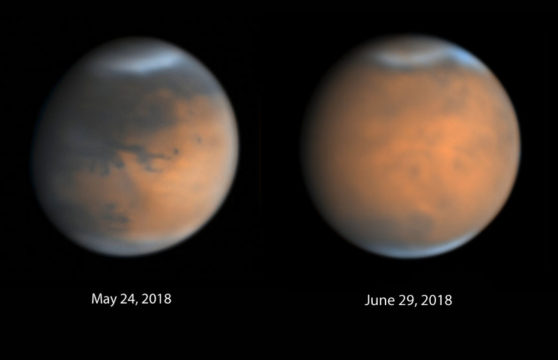
Damian Peach / ChileScope Team
But we're not out of the woods yet. With Mars at perihelion on September 16 and summer approaching in the planet's southern hemisphere, conditions are ideal for — you guessed it — dust storm formation! Just as skies begin to clear from the present tempest, Mars could get wracked by another. Is there no justice?
"I wish we could predict when and how long these storms come and go, but every time I try, Mars changes, and nothing works out like we think," said Jeff Beish, former ALPO Mars Recorder, in an e-mail. "In any case I suspect plenty of dust will remain in Mars's atmosphere for the next 6 months, and it will create lots of H2O and CO2 clouds."
Beish's observation about clouds helps us to take stock of what we can enjoy should nature dally in cleaning up this mess. With the planet rising earlier every night, opportunities for observation increase throughout the summer. I use Sky & Telescope's Mars Profiler to find out which hemisphere of the planet faces my location at the time I'm observing. If the seeing's decent, I'll up the magnification to 200x or higher and try to make out the most prominent dark markings or the polar cap. Having trouble seeing anything? Try a red filter to improve surface feature contrast; a Wratten 25 or 29 (for bigger scopes) works well. For vapor clouds, use a Wratten 80A or 82A.
While the planet may look virtually featureless at the moment, keep in mind we're seeing one of the grandest and possibly the most unique dust storm in decades. When you share views of the Red Planet with friends, family and the public, give them a sense of its size (as large as all the land mass of Earth) and duration. The Dust Bowl of 1930s America barely compares.
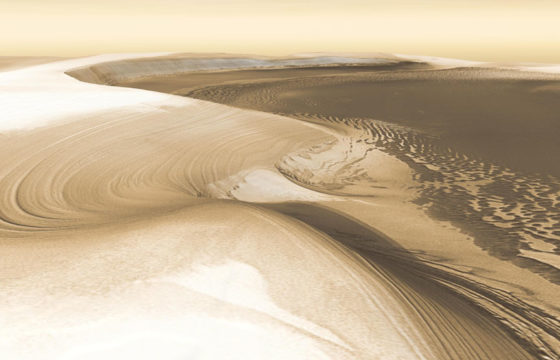
NASA / JPL-Caltech / ASU
Photos taken of the Martian north and south polar regions from orbit reveal a laminated terrain with alternating layers of ice and dust deposited by storms like the present one. Think about it — we're witnessing the creation of a new layer in the climatological record of the Red Planet. One day perhaps, astronauts will excavate a core sample from the south pole and trace the signature of the 2018 global storm.
Dust means lots of nuclei available for cloud formation. Keep an eye out for clouds; they look like bright patches and show up best near the planet's limbs. Planetary observers know that the more you look the more you see including the the planet's return to normal. Always expect surprises, too ... but of course you knew that already 🙂
Resources:
- Mars Profiler: find out which side of Mars and what features are visible
- 2018 Mars Gallery: the latest photos from amateurs around the world
- ALPO 2018 Perihelic Opposition Guide to Mars
- Mars weekly weather: reports based on Mars Reconnaissance Orbiter imagery
 21
21









Comments
Joe Stieber
July 11, 2018 at 2:58 pm
My most recent look at Mars was on the morning of July 9, 2018. With my 130 mm apo refractor at 253x, the view was very similar to Pellier’s image of July 7. The south polar cap was a whitish dot with a dark rim on the northern edge, there was a slash of white at the northern limb, but the disc itself was mostly featureless. There was just some vague, slightly darker mottling, not enough to match up with any of the Martian surface feature diagrams. Ironically, in early June, I observed Mars with my 80 mm apo refractor and saw a surprising amount of detail. I was really looking forward to the view with the 130 mm scope, but by time I got it out at the end of June, it was too late. Oh well, I’ll just have to keep checking and hope for the best.
You must be logged in to post a comment.
Bob KingPost Author
July 11, 2018 at 5:15 pm
Hi Joe,
Thanks for sharing your recent observations. I was frankly surprised last night when I observed the planet with Syrtis Major on the CM. Seeing wasn't the best but even when Mars sharpened up I was unable to distinguish any markings except for a faint, amorphous gray in the middle of the disk. I used a red filter to cut the glare and increase contrast, and at least in this case, it didn't help. This is one amazing storm!
You must be logged in to post a comment.
Rod
July 11, 2018 at 4:15 pm
[Like you, I've attempted visual observations in 10-inch and 15-inch telescopes but have been stymied to identify much of anything. At best I've seen a few ambiguous gray markings, a vague, low-contrast south polar cap, and the white northern rim of the planet betraying the presence of the north polar hood. Otherwise, Mars is mostly a tease right now: brilliant and big in the telescope but cloaked in a gritty fog. Have you noticed the change in the planet's color? Normally reddish-orange or even pink, Mars now glows yellow-orange. Even my eyes can see the difference. ALPO assistant coordinator Richard Schmude has also noted an increase in brightness of ~0.2 magnitude concurrent with the color change.]
I see these conditions using my 90-mm refractor and Mars is indeed yellowish without the red filter I use (#23A) viewing at 180x and 200x. I viewed early this morning near 0100 EDT. I have a 10-inch but did not setup. Nights are warmer now and that takes some effort and sweat to carry out into horse pastures 100 yards or so for viewing 🙂
You must be logged in to post a comment.
Bob KingPost Author
July 11, 2018 at 5:16 pm
Hi Rod,
Thanks for your sharing your observation and for the confirmation of the planet's color. It looked particularly yellow to my eyes last night.
You must be logged in to post a comment.
Anthony Barreiro
July 11, 2018 at 8:28 pm
I am less distressed at not being able to see surface features than I am entranced that we are witnessing a global weather event from a distance of 0.41 AU. Thanks for explaining the meteorology. I guess the principles are pretty consistent from one planet to the next. It's also consistent that we always blame the weatherperson when we don't like the weather!
You must be logged in to post a comment.
Bob KingPost Author
July 11, 2018 at 11:14 pm
Well said, Anthony. I'm trying to appreciate the bright side (excuse the pun) of such an unusual event. Cheers!
You must be logged in to post a comment.
Bob
July 12, 2018 at 1:17 am
After reading this article and comments, my observations of Mars with 10x70 binoculars explains the great pumpkin in my eyecups.
It's the Great Pumpkin Charley Brown -- Intro only
https://www.youtube.com/watch?v=TRGkEDADmRU
Ha! Ha!
You must be logged in to post a comment.
Bob KingPost Author
July 12, 2018 at 10:38 am
You nailed it, Bob. That's the color — pumpkin!
You must be logged in to post a comment.
Joe Stieber
July 12, 2018 at 1:22 pm
I’m not sure where I first saw it (years ago), but I think “butterscotch” is a good description of Mars’ color.
You must be logged in to post a comment.
FlyglesGalaxy
July 21, 2018 at 1:31 pm
I recognize that Hadrosaurus! Haddonfield, NJ resident here, and I echo you Joe that butterscotch is the perfect description. It's a shame that weather on both planets is threatening the opposition viewing.
You must be logged in to post a comment.
Rod
July 12, 2018 at 11:35 am
Yes indeed. I went back and reviewed my stargazing log (MS ACCESS DB). When I observed Mars on 06-Jan-18 during close alignment with Jupiter in Libra, it was very reddish color near whitish Jupiter and made for a beautiful color contrast in the early morning sky, all in the same low power field of view. On 09-July-18, I observed Mars using 53x and 1.2 degree true field without filters retrograding in Capricornus since 28-Jun. Yellowish pumpkin color and also yesterday morning too. The dust storm is definitely causing some obscuring and changes now. Folks, keep up the good Mars observing and logging. I have logged regular observations of Mars since 06-Jan-18 close alignment with Jupiter and plan to continue through opposition and close approach to earth later this month.
You must be logged in to post a comment.
Terry_the_Geek
July 13, 2018 at 6:22 pm
I might get attacked, but what if this was a volcanic eruption and not just a dust storm?
You must be logged in to post a comment.
Aqua4U
July 13, 2018 at 8:28 pm
My goal during this opposition was/is to see Phobos? Here's hoping the extra illumination from the dust storms doesn't interfere with that goal? I have a Celestron No.21 filter.. which I assume is a Wratten 21 for my 12 1/2" Newt. I also have a Celestron green No.56, a Blue No 80A, a Meade Neutral Density ND96 and a Lumicon OIII - Hydrogen-Beta. Will try them all.. just because.
Just read a S&T article published on July 25, 2005 by Roger Sinnot and Adrian Ashford that chats up making an 'occultation bar' with a strip of alum foil.. I think I'll try that too!
The Meade ND96 worked really well on Jupiter and Venus! My 12 1/2" is an f3.6, so doesn't perform as well as I'd like with brighter objects but with this filter, I was finally able to see Jupiters bands and the GRS.
Thanks for the tips Bob.. you rock!
You must be logged in to post a comment.
Bob KingPost Author
July 15, 2018 at 7:55 pm
Hi Aqua,
I don't think the extra illumination from dust will hurt. It could even brighten up Phobos a hair, too. The main thing is the occultation bar. You make that, and your chances for seeing the moon will improve greatly. It's really the only way.
Deimos is easier - get that one first, then go for Phobos. Good luck!
You must be logged in to post a comment.
AlphaCentauri
July 14, 2018 at 6:05 pm
I finally have a telescope that will let me see the polar caps and some of the surface features and this happens. I guess I'll have to be satisfied with whatever I can see. At least Saturn is in view. I never get tired of looking at it.
You must be logged in to post a comment.
philip-gardner
July 15, 2018 at 5:25 am
So how do those first journey persons and astronauts survive in a 4 month dust storm? Wait it out or escape at first sight of a willy willy? Any guess at visibility on the ground (I guess Opportunity could show us)?
You must be logged in to post a comment.
Bob KingPost Author
July 15, 2018 at 8:00 pm
Hi Philip,
As of the last report, it was extremely dark — like night — on the ground at Opportunity. Visibility would have been near zero and may still be very limited. Too little sunlight to stir a current in the solar panels. Good question about the astronauts. They'd have to take that into consideration in planning and land during a relatively dust-storm-free time in the Martian year for a short mission.
You must be logged in to post a comment.
Anthony Barreiro
July 20, 2018 at 4:35 pm
We should just keep sending robots. For the cost of one brief and largely symbolic human mission we could send thousands of robots to spend years on Mars or in Martian orbit. As we're seeing with Opportunity, solar-powered robots can just go to sleep during a dust storm, and nuclear-powered robots like Curiosity continue to function just fine, they don't go mad from lack of sunlight. And we can sterilize robots to prevent any contamination of Mars by terrestrial microbes. Humans would inevitably introduce bacteria, viruses, and fungi to Mars. You can't boil an astronaut.
You must be logged in to post a comment.
ron
July 19, 2018 at 2:56 pm
Are any features currently on Mars clearing up,that you can see with a small Telescope? Thanks Ron
You must be logged in to post a comment.
Anthony Barreiro
July 20, 2018 at 4:29 pm
https://skyandtelescope.org/observing/this-weeks-sky-at-a-glance-july-20-28/
You must be logged in to post a comment.
ron
July 22, 2018 at 5:24 pm
We need a Mars Robotic sample return mission.Enough of these Mars surface labs missions
You must be logged in to post a comment.
You must be logged in to post a comment.